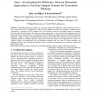Free Online Productivity Tools
i2Speak
i2Symbol
i2OCR
iTex2Img
iWeb2Print
iWeb2Shot
i2Type
iPdf2Split
iPdf2Merge
i2Bopomofo
i2Arabic
i2Style
i2Image
i2PDF
iLatex2Rtf
Sci2ools
INTERACT
2003
2003
Zazu - Investigating the Difference between Interaction Approaches in Advisory Support Systems for Curriculum
: Curriculum planning for students in a university which offers full-time as well as part-time courses is not a trivial task and is complicated by the fact that students can enrol for modules at different levels concurrently. A prototype advisory support tool was developed to address the problems related to documentbased advising. The tool supports two interactive advice approaches – a top-down backward-chaining style and a bottom-up forward-chaining style. An experiment with 20 participants compared these two different interaction approaches within a natural curriculum-planning context. The results show important design tradeoffs for supporting people in curriculum planning. This paper presents the results of the experiment. We discuss the cognitive aspects and implications for each interaction approach and how some UI design guidelines are supported and then draw conclusions about how best to structure user interaction in an advisory support tool based on the results.
Advisory Support Tool | Curriculum Planning | INTERACT 2003 | INTERACT 2007 | Top-down Backward-chaining Style |
| Added | 31 Oct 2010 |
| Updated | 31 Oct 2010 |
| Type | Conference |
| Year | 2003 |
| Where | INTERACT |
| Authors | Judy van Biljon, Karen Renaud |
Comments (0)

